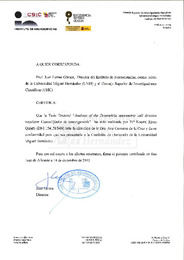Título :
Analysis of the Drosophila asymmetric cell division regulator Canoe/Afadin in tumorigenesis |
Autor :
Rives Quinto, Noemí |
Tutor:
Carmena de la Cruz, Ana |
Departamento:
Instituto de Neurociencias |
Fecha de publicación:
2016-03-10 |
URI :
http://hdl.handle.net/11000/3436 |
Resumen :
Stem cells divide asymmetrically to give rise to one daughter cell that inherits the self-renewal potential and another daughter cell that is committed to differentiate. Hence, an impairment of the asymmetric cell division (ACD) process could render daughter cells with altered cell fates, unable to respond to cell growth control mechanisms. Indeed, over the past years an intriguing connection between ACD, stem cells and cancer biology has emerged. We previously showed that the PDZ protein Canoe (Cno) regulates ACD in embryonic neuroblasts (NBs), the neural stem cells of Drosophila central nervous system (CNS). In this work, we wanted to investigate whether the loss of cno in asymmetrically dividing NBs could lead to tumor-like overproliferation. We show that Cno is expressed in NBs and Intermediate Progenitors (IPs) of Drosophila larval brain type II NB (NBII) lineages. In cno mutant clones the ACD regulators aPKC, Pins and Dlg fail to form crescents and they accumulate all around the cortex or are mislocalized. Other defects such as size-reduced NB and abnormal morphology of the cno mutant clone are observed. Despite these failures, cno mutant clones do not show overgrowth. In fact, fewer IPs and Ganglion Mother Cells (GMCs) are detected. In addition, we have found that type II NB mutant clones of scribble (scrib), a well-known tumor suppressor gene, do not overgrow either. Moreover, most scrib mutant clones die. Intriguingly, the simultaneous loss of function of cno and scrib synergistically interacts displaying an overproliferation of progenitor cells that show disrupted cell polarity and give rise to a tumor-like overgrowth. Removing Ras signaling in the cno, scrib double mutant background rescues the overgrowth phenotype. In addition, the ectopic activation of Ras in cno, scrib double mutant clones does not seem to signal through the Raf-MAPK cascade in Drosophila brain NBs. Our data reveal a novel synergistic interaction between cno and scrib loss of function in NBII lineages that lead to tumor formation by, at least in part, an up-regulation of Ras signaling.
|
Palabras clave/Materias:
Células-División
Marcadores tumorales |
Área de conocimiento :
CDU: Ciencias aplicadas: Medicina: Patología. Medicina clínica. Oncología: Neurología. Neuropatología. Sistema nervioso |
Tipo de documento :
info:eu-repo/semantics/doctoralThesis |
Derechos de acceso:
info:eu-repo/semantics/openAccess |
Aparece en las colecciones:
Tesis doctorales - Ciencias de la Salud
|
 La licencia se describe como: Atribución-NonComercial-NoDerivada 4.0 Internacional.
La licencia se describe como: Atribución-NonComercial-NoDerivada 4.0 Internacional.
.png)
